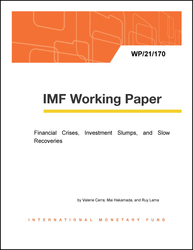
Financial Crises, Investment Slumps, and Slow Recoveries
Financial Crises, Investment Slumps, and Slow Recoveries
READ MORE...
Volume/Issue:
Volume 2021
Issue 170
Publication date: June 2021
ISBN: 9781484325278
$20.00
Add to Cart by clicking price of the language and format you'd like to purchase
Available Languages and Formats
| English |
Prices in red indicate formats that are not yet available but are forthcoming.
Topics covered in this book
This title contains information about the following subjects.
Click on a subject if you would like to see other titles with the same subjects.
Banks and Banking , Labor , Economics- Macroeconomics , Economics / General , Medium-term TFP loss , impulse response , investment dynamics , hysteresis effect , aftermath of a financial crises , Total factor productivity , Global financial crisis of 2008-2009 , Banking crises , Self-employment , Global
Summary
One of the most puzzling facts in the wake of the Global Financial Crisis (GFC) is that output across advanced and emerging economies recovered at a much slower rate than anticipated by most forecasting agencies. This paper delves into the mechanics behind the observed slow recovery and the associated permanent output losses in the aftermath of the crisis, with a particular focus on the role played by financial frictions and investment dynamics. The paper provides two main contributions. First, we empirically document that lower investment during financial crises is the key factor leading to permanent loss of output and total factor productivity (TFP) in the wake of a crisis. Second, we develop a DSGE model with financial frictions and capital-embodied technological change capable of reproducing the empirical facts. We also evaluate the role of financial policies in stabilizing output and TFP in response to disruptions in financial markets.
Copyright © 2010 - 2025
Powered by:
AIDC



